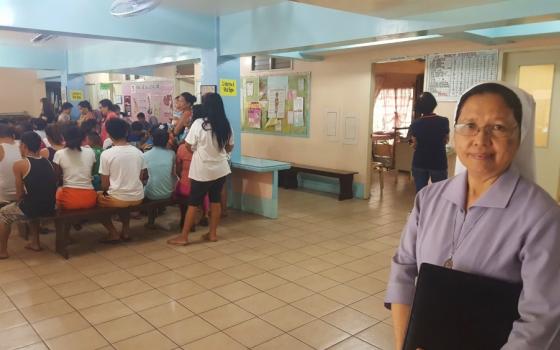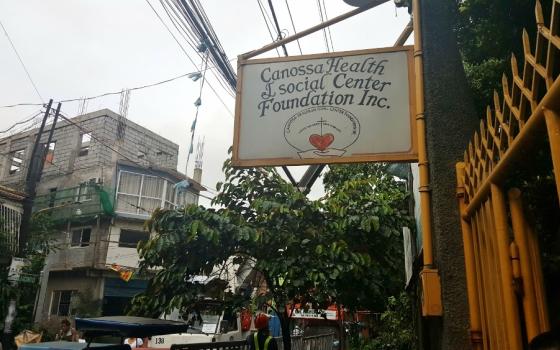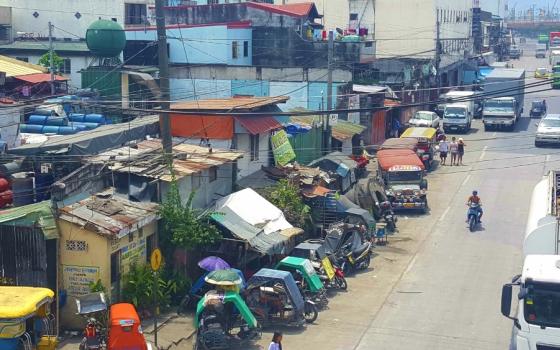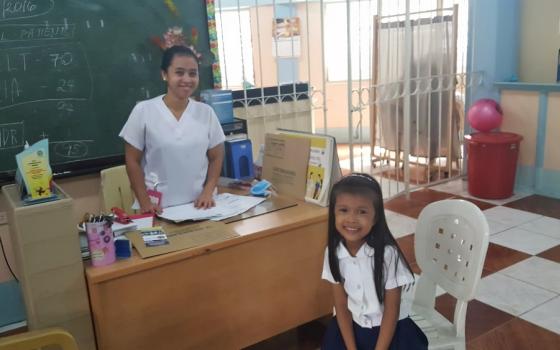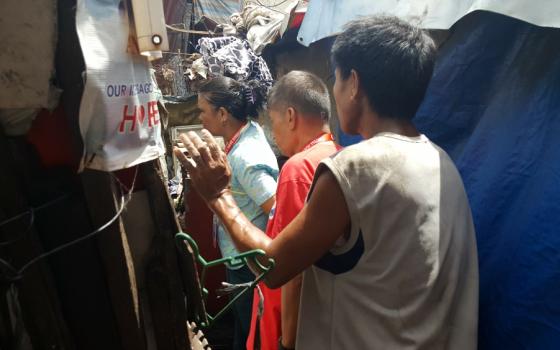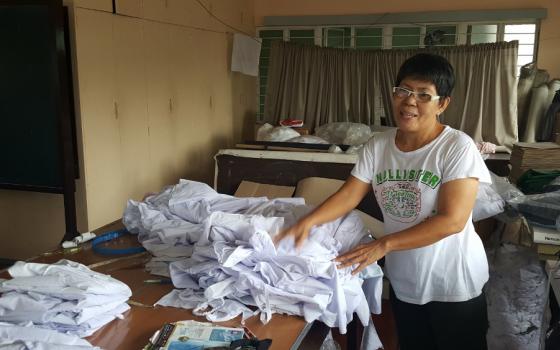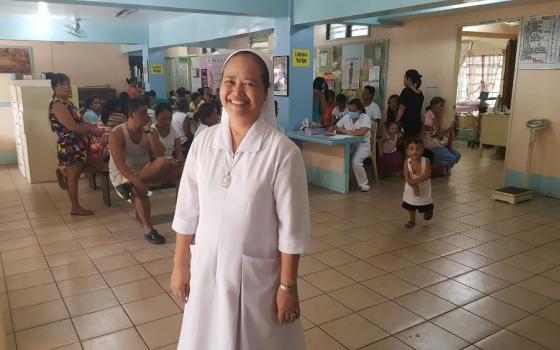It is mid-morning on a warm Friday in the Philippines capital of Manila, and dozens of patients are already in the waiting room. A nurse uses a microphone to remind them that there is a queue and everyone will get their chance to consult with the doctor. The Canossa Health and Social Center serves as an oasis of calm and order in the slums of Tondo, one of the most economically poor sections of the city of 1.7 million people.
Children play in the courtyard, some of whom came from next door where the Canossa-run day care center is. Beyond that is a separate building where staff and the Canossian Daughters of Charity, Sacred Heart Province are waging a battle against tuberculosis (TB).
"It is our dream to have a TB-free Philippines," said Canossian Sr. Susan Imperio, who was recently assigned as community leader for the center. "Treating one client is treating the family as well, because you prevent the disease from spreading."
The Canossa Health and Social Center is one of the frontline efforts in the Philippines to help fight tuberculosis. Its TB clinic is part of a system in which private and public health care providers work together, following international health care standards, to control the spread of and work to eliminate the lung disease, which can be fatal if not treated. It is the number-one cause of death for people infected with HIV.
In the Philippines, private clinics and hospitals use their own space, staff and funds to serve TB patients while the government's Department of Health (DOH) provides technical assistance, anti-TB drugs, and laboratory supplies and forms.
The sisters' personal approach to providing care and incentives for patients to take needed medication helps ensure compliance. Tuberculosis patients are provided daily breakfast during the course of treatment, Imperio explains. After they've had breakfast, clinic staff distribute their medication and watch patients take them.
The Philippine's National TB Control Program (NTP) adopted this directly observed treatment short-course (DOTS) strategy in 1996 and has credited it with significant inroads to defeating TB. The medicine has to be taken with food, and since people living in poverty often lack meals, giving them breakfast and watching to be sure they take the right dosages helps ensure treatment compliance. According to NTP's most recent review, there have been progressive declines in TB prevalence and incidence as targets in treatment success rates have been achieved.
However, the Philippines is still among the 22 countries identified by the World Health Organization (WHO) in 2000 as high TB burden countries, that accounted for some 80 percent of the global total of estimated new cases of TB. As of 2015, the WHO estimates some 324,000 incidences of tuberculosis in the Philippines, about 31,000 of whom are children ages 14 years old and younger.
Imperio, who is a registered nurse and has been in religious life for 27 years, said that the Health Center's DOTS Clinic follows the guidelines and protocols of the national tuberculosis program, which stresses strategic adherence to compliance to medication.
The Canossa-run DOTS Clinic currently has 95 patients — 70 adults, 24 children, and one multi-drug resistant patient. Their oldest patient is about 82 years old, while their youngest is a two-year-old child, said registered nurse Chyrna Ricci Mendoza. She said that they receive walk-in patients and referrals from other clinics and hospitals in the area. Once at the clinic, a patient is given a sputum exam and a chest x-ray.
The clinic's microscopy for phlegm examination is run by lay staff who received technical training from the DOH, like Marieta Budito Isidro who has been at the center for 17 years.
When tuberculosis is confirmed, the next step is to determine the treatment plan. Mendoza explained that the clinic offers three kinds of treatment depending on the gravity of the disease — patients in Category 1 go through a six-month course of medication, those in Category 2 for eight months, while multi-drug resistant patients have to go through a two-year treatment.
Mendoza's commitment to the clinic and the sisters is personal as well as professional. "I was nursing student when I was diagnosed with TB at 19 years of age. I was treated here," Mendoza said. Her experience influenced her decision to specialize as a private-public mixed DOTS nurse. After she passed her licensing exam for nursing, Mendoza returned to the clinic to work.
The clinic has been identified as the primary treatment center for TB patients from six barangays (the smallest political unit in the Philippines) surrounding and near the clinic. She said that there are about 38,000 people who live in these barangays, most of whom are indigent, scavengers or garbage collectors. The Health and Social Center is located in Tondo, which is well known for being the location of Smokey Mountain, a garbage dump closed in 2014 but known for the tens of thousands of people who lived by scavenging from it.
Ember Nilbert, 6, is among the young children diagnosed with TB. Her mother, Nilda Montecavo, said she didn't think her daughter had TB when she became sick, thinking she just had a cough. Her daughter was sleeping, Montecavo said, "when she turned black and couldn't breathe. It happened again after a week. She had thick phlegm." Montecavo decided to bring her daughter to the Canossa clinic to be examined.
With the diagnosis, Montecavo makes sure that she brings her daughter daily to the clinic to receive her medication. Like many in the community, Montecavo is unemployed, and her husband, Gilbert, who is 35 years old, does whatever work he can find. She said he mostly works as a helper in the public market, pushing carts for vendors to deliver supplies.
Even though the Philippine government requires that infants be vaccinated against tuberculosis, poor sanitation and nutrition, high density housing, and lack of knowledge contribute to children and adults being prone to infection, said Imperio, the clinic head. "If people have low resistance, they are easily afflicted with common diseases or opportunistic infections," she said, adding that many of their patients are underweight.
Though the Philippines has seen about 92 percent success in the treatment of TB, there continue to be new cases detected. Under a law signed last year by former president Benigno S. Aquino III, the government's focus is shifting from reducing and controlling TB prevalence and mortality towards eliminating it as a public health problem. Globally, the World Health Assembly and the United Nations Sustainable Development Goals have set a target of ending the TB epidemic by 2030.
Aside from helping TB patients manage their illness, Imperio said that they also watch out for hepatitis and HIV/AIDS among some of their more vulnerable patients. Through the local government's Manila Health Office, some of the clinic's pregnant patients are tested for HIV/AIDS.
Imperio moved to the Canossa Health and Social Center in Tondo in June after spending several years caring for elderly Canossian sisters at their central infirmary in Manila.
The Canossaian Sisters began their ministry in Tondo, Manila in 1971, when four sisters were assigned to help two Pontifical Institute for Foreign Missions priests in the newly formed San Pablo Apostol Parish in Magsaysay Village. Located in the vicinity of the port of Manila, the village comprises old and new tenement housing on reclaimed land.
In 1973, the sisters rented a two-door apartment, using one room as a clinic. The sisters focused their efforts towards living their mission of education, evangelization, and care for the sick and suffering. In 1979, the Canossa Province with the help of Caritas-Miserior Germany gifted the community of sisters with the existing building of the Canossa Health and Social Center, a two-story structure containing the clinic, delivery room, pharmacy, sewing center, juice-making facilities, and living quarters for four Canossian sisters and some members of staff.
Aside from its DOTS clinic, one of the health centers more popular services is the maternal and child-care clinic run by registered midwife, Rhonna Galino, who has been working at the clinic for nine years. She initially volunteered at the clinic while studying to take her board exams for midwifery. After getting her license, she continued to volunteer at the clinic until she was hired as a member of staff.
Galino handles the maternal and child care clinic on Wednesdays; and on other days, she works at the clinic's small pharmacy. In the years she's worked at the clinic, she said she's delivered hundreds of babies, "almost every month there is one."
When necessary, patents are brought to the nearest hospital for further care, but that is rare. "From being a student to working here, my skills have been honed," said Galino.
The clinic accepts pregnant women 18 years old and above. Galino said the younger mothers are more difficult to manage because of stubbornness and negligence in taking their pre-natal medicines. Her years of experience has led her to say, "during assessment, I know who hasn't been taking their vitamins without anyone saying anything."
The center's health workers also make herbal medicine: lagundi and ointment made from leaves of the guava plant. Lagundi has been endorsed by the Philippine Department of Health for treatment of respiratory ailments. The clinic's health workers steep the lagundi leaves, roots, flowers and seeds to a drinkable syrup and bottle it and sell for 50 pesos (U.S. $1.01). The health workers also make guava ointment that can be used as an antiseptic or to relieve itchiness. The ointment is sold for 25 pesos at the clinic's pharmacy.
Canossa Sr. Regina Angela Barcelon began working at the health center when she was still an aspirant. "I spent my weekends and semester break here when I was still studying to be a nurse," Barcelon said. She remembers having to transfer medicine, donated by Miserior, that was in gallon containers into small bottles so that they could be distributed to the local community. She said she had to clean and sterilize bottles first and then to carefully pour in the medicine.
She stopped volunteering at the center as she pursued her studies but returned in 1983 as a junior sister. She stayed for five years before being reassigned to other Canossiaa communities around the Philippines. She returned to the Tondo center because she found the work rewarding, adding that she has formed good relationships with the people they serve. "Many of our health workers have been here 17 years or more. Some started as patients," Barcelon said. She has become like family to those who work at the center and to members of the community who have been going there throughout the years.
One such person is Nelson Abarrientos who has volunteered at the center for 12 years. In 2004, he contracted TB and, after receiving treatment, started volunteering in 2005. "I wanted to help here after my treatment, after seeing what the sisters did," Abarrientos said. He runs errands, accompanies staff when they make home visits, and other odd jobs he's asked to do.
Letty Tabao is one of the lay health workers here. "When I was a child, I just went with my friends to the center. Then, when I gave birth to my daughter, I joined their feeding program. I also took their high-speed sewing course," Tabao said. Now, she helps the sisters look after patients by visiting them at home when they hear that they are not taking their medication.
On this Friday, Tabao is visiting an elderly man who has TB but hasn't been taking his medication. With ease, Tabao threads the maze of shanties built out of corrugated metal and pieces of plywood surrounding the former tenement housing buildings. She goes through narrow alleys, where you can see fighting cocks tied to stakes, stray dogs roaming and children running around. When she arrives at the elderly man's home, she asks him through the window why he hasn't been taking his medication. They have a short conversation, and Tabao said that he promised to do better.
According to Tabao, some of their elderly patients lose their appetite and have difficulty swallowing, which affects the way their TB is managed, and this is where family becomes important. Before leaving the elderly man, Tabao talks with a relative who lives with her elderly patient to give them instructions on what breakfast to serve so he can eat and then take his medication.
It may seem to be a small success — but through such cases the sisters achieve the larger mission — and it is not an insignificant achievement for this one patient.
______
Jobs training and juice: Sustaining the ministry
Although primarily known for its health services, the Canossa center also helps provide training and some employment for residents in the surrounding area. Marcita Zamora, 56, has worked at the Canossa Health and Social Center for 31 years. Zamora runs the sewing program, providing livelihood and skills training for a minimal fee. Together with one other full-time staff and five seasonal workers, she sews the T-shirts and jogging pants for the Canossa-run schools in Luzon. They are very busy from January to July sewing these physical education uniforms for all the Canossa students.
Zamora also trains some 10 to 15 adult students who enroll in her 4 to 6-month dressmaking/tailoring course or 2-month high-speed sewing course. The center accepts male and female students who have at least finished elementary school into the courses, which cost 2,000 pesos (U.S. $40) and 1,500 (U.S. $30), respectively. After finishing the courses, Zamora says that her former students often get jobs in the apparel industry.
To help finance the clinic and provide a healthy beverage, Canossa Sr. Dinnah Dimaano, runs the center's calamansi juice program that began in 2000. The juice is from small citrus fruit, often described as the Philippine lime. Dimaano goes to the market district of Manila every week to buy six bags of 30 kilos each of calamansi. Their one fulltime staff then juices the fruit, with other staff hired on a temporary basis when there is an increased demand. The fruit concentrate is then mixed with water and other ingredients to make the juice, which is bottled in 330ml plastic bottles.
The income from the center's sewing and juice programs helps supplement the center's funds for its feeding, health, and education services. Through the center, the Canossian Sisters has become an integral part of the community, continuing their mission of education, evangelization, and care for the sick and suffering that began in 1971.
[Charity Durano is a correspondent for GSR based in the Philippines.]
